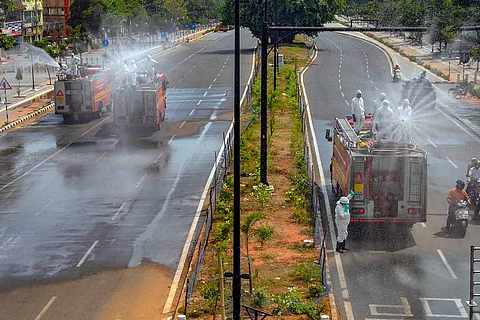

The Bruhat Bengaluru Mahanagara Palike has so far declared 38 wards in Bengaluru as hotspots for novel coronavirus. “We have identified 38 wards that are hotspots so far. This number can change depending on whether or not people from other wards test positive in the days to come,” said Randeep Dev, Special Commissioner, BBMP.
The wards that have been identified include Thanisandra, Byatarayanapura, Chinnasandra, Begur, Radhakrishna Temple, Hagadoor, Garudachar Palya, Varthur, Hoodi, Horamavu, Ramamurthy Nagar, Vasanth Nagar, Ganga Nagar, Jeevan Bhima Nagar, CV Raman Nagar, Sampangi Rama Nagar, Lingarajapura, Ramaswamy Palya, Maruthi Seva Nagar, Giri Nagar, Adugodi, Suddaguntepalya, Shakambari Nagar, JP Nagar, Gurattana Palya, Bapuji Nagar, Hosahalli, Sudham Nagar, Madiwala, Attiguppe, Karisandra, Aramani Nagara, Nagarbhavi, Nagapura, Shivanagara, Azad Nagar, Jagjeevan Ram Nagar and Subhash Nagar.
As of Wednesday morning, Bengaluru had 80 of the 258 COVID-19 cases in Karnataka. Of them, 31 people have been discharged and two have died in the state. With the number of COVID-19 cases increasing in the city, the BBMP has revised the definition of a hotspot and even if an area has one positive case, the BBMP is declaring it as a hotspot for novel coronavirus.
According to the new definition, a hotspot is an area with an administrative boundary. That is, a revenue village in rural areas, or a ward in urban areas, that have at least one COVID-19 case that was reported in 28 days (counting back from April 11). “Either one person must test positive or at least 50 contacts of a positive patient must reside in this particular administrative area,” Randeep added.
BBMP Commissioner Anil Kumar said that the purpose of classifying these areas as hotspots was to ensure ease of carrying out the contact tracing process. “Once an area is classified as a hotspot, we begin to trace primary and secondary contacts and also put in place the containment measures to be taken surrounding the 3 km radius of the person’s house. Only when there is a dramatic spike in cases, say there are four or five people who test positive in a day or within a short period of time, that’s when we decide whether the ward should be sealed,” he added.
Randeep, however, said that only two wards have been sealed off including Bapuji Nagar and Padarayanapura. “The containment zone will be within a 3 km radius of the residence of the person who has tested positive. When any place is completely sealed off, we will inform people about it. There is no need to spread rumours that just because we have identified 38 hotspots, we are sealing off all of them,” said Dr Vijayendra, Chief Health Officer of the BBMP.
“We have not yet decided whether more tests will be conducted in these hotspots. We are waiting for the kits to arrive,” he said.
If there are more cases in a hotspot, it can be declared a containment zone.
What does containment mean?
Other than imposing restrictions on movements in containment zones, the authorities also do mass active surveillance, passive surveillance, contact tracing and mass disinfection.
1. People living in these zones are surveilled on a daily basis for COVID-19 related symptoms.
2. When any symptoms are reported by the health staff, a medical team is rushed to the spot to verify them. Patients may be asked to be in home isolation or shifted to hospital isolation.
3. Announcements by microphone are done in the entire containment zone and the buffer zone explaining symptoms and preventive measures.
4. Temporary medical camps are set up.
5. All the possible contacts of the 'index case' is identified and listed. They are asked to be on hospital quarantine and also tested.
6. Designated 108 ambulances are parked in these zones. They are used exclusively for transport of possible COVID-19 patients or suspected cases.
7. All the houses, public places in the containment zone are disinfected through various measures.
Editor's note: The names of hotspots were updated after the report was published to reflect the latest information given by BBMP.